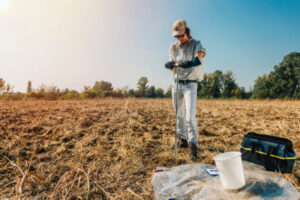Why Do You Need a Phase I ESA?
When purchasing commercial/industrial/large residential property, it is always a good idea to obtain a Phase I Environmental Site Assessment (ESA) to understand current and past uses of the property, along with the potential presence of environmental contamination.
Point Enviro can perform a Phase I ESA using current ASTM standards which meet the standards set by the Comprehensive Environmental Response, Compensation, and Liability Act (CERCLA).

Point Enviro’s trained professionals have performed hundreds of Phase I ESAs for commercial, agricultural, industrial, and even residential transactions. When you need to know whether a property is or has been contaminated, turn to Point Enviro for all your environmental needs.
What is an Environmental Site Assessment
A Phase I ESA is the limited investigation of a property (usually one being purchased or refinanced) performed by an environmental professional to determine the potential presence of recognized environmental conditions (RECs).
The Environmental Protection Agency defines “All appropriate inquires” as follows:
“All appropriate inquiries” is a process of evaluating a property’s environmental conditions and assessing potential liability for any contamination. All appropriate inquiries must be conducted to obtain certain protections from liability under the federal Superfund Law (CERCLA).
The term recognized environmental conditions (REC’s) means the presence or likely presence of any hazardous substances or petroleum products in, on, or at a property:
(1) due to any release to the environment;
(2) under conditions indicative of a release to the environment; or
(3) under conditions that pose a material threat of a future release to the environment.
De minimis conditions are not recognized environmental conditions.
A buyer of a property will want to uncover any potential liability risks related to soil and groundwater contamination prior to its purchase. Environmental professionals evaluating the subject property review both current and past use of the property to determine the potential for possible environmental impact that could have occurred during the property use.
The property’s history is very important, because there are many cases where property use has changed over time. For instance, an investor may be looking to purchase an existing retail shopping center. If a dry-cleaning business was once present, there is a risk of prior environmental impact that would need to be further evaluated.
There are a number of factors or situations in which a Phase I assessment may be helpful or even required. Let’s start with some of the most common situations.
Many commercial lenders including banks and private equity firms may require a buyer to provide a Phase I ESA to secure project funding.
Projects receiving funding from non-governmental organizations like Fannie Mae, Freddie Mac or the Small Business Administration are required to complete a Phase I ESA.
Any individual or entity purchasing a commercial, agricultural, or industrial property whether is it self-funded or using third party funds.
The main reason for obtaining a Phase I ESA is to protect a buyer by providing them with information about the environmental state of the property intended for purchase. Instead of ‘buyer beware’, a Phase I can be ‘buyer aware’.
In many cases, if the purchase of a site involves lending from private or public sources, the lender may require a Phase I ESA with loan application or during the loan review process.
Aside from lending requirements, a Phase I ESA can help manage risks. If a buyer acquires a site without a Phase I and later discovers the site is contaminated, the buyer is responsible for cleaning up the contamination, something that can be very costly.
A trained environmental professional will conduct a review of numerous current/historical records combined with an on-site inspection of the property as well as accessible portions of the building (interior and exterior). Interviews with current and previous tenants are also utilized.
If the environmental professional identifies Recognized Environmental Conditions (REC’s) during the course of the Phase I Investigation, a Phase II Environmental Site Assessment may be recommended/required. A Phase II Site Investigation involves the collection and analyzing of samples to determine the type and extent of contamination. This may involve soil, water and/or air.
Point Enviro’s professionals have the experience to ask the appropriate questions to help provide you with an estimate of the time needed to complete a Phase I ESA. Call our team today to learn more or schedule a consultation.
Call Us
Contact us at 201-690-7008
Email Us
Do you have a question? Click to contact us by email
Request Service
Fill out our service request form
